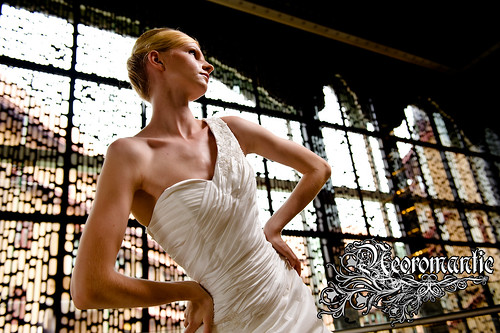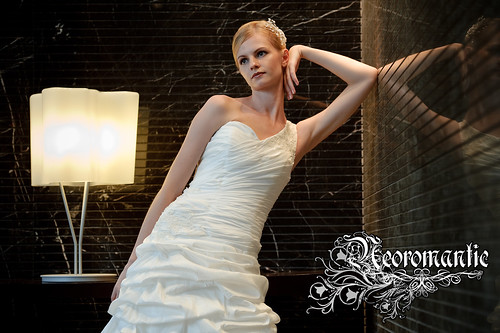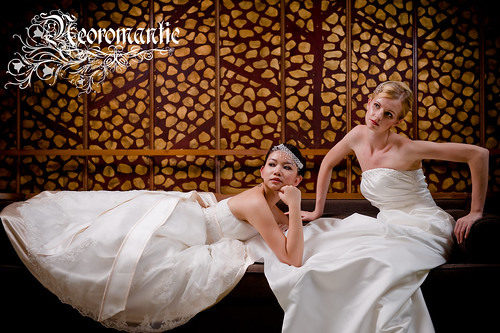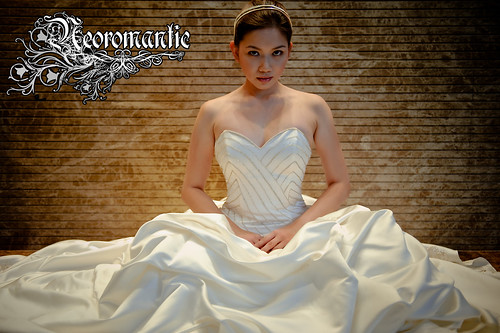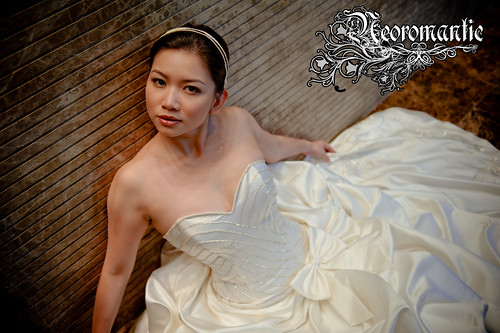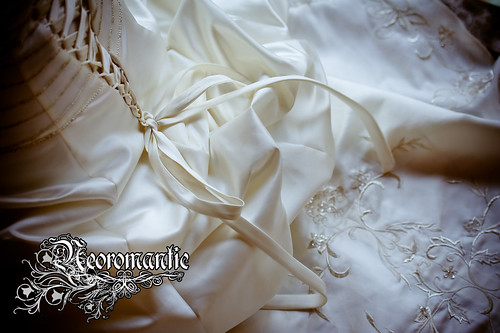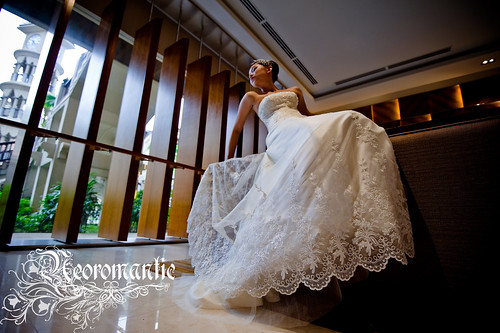How To Make Shorter Legs Look Longer In Photos
Labels: Advice, Tips, Wedding Traditions
How To Make Shorter Legs Look Longer In Photos
Do you have short legs and a long torso? Or do you simply have short legs. For the illusions of height the photographer will normally place the camera slightly below the waist but above the knee level to capture an 'extended' body.
Another tip is placing props in the background on lower points so that you appear taller in comparison.
The dress that you wear can also make a huge difference as well. High heels are essential too.
Source: Female Brides
Do you have short legs and a long torso? Or do you simply have short legs. For the illusions of height the photographer will normally place the camera slightly below the waist but above the knee level to capture an 'extended' body.
Another tip is placing props in the background on lower points so that you appear taller in comparison.
The dress that you wear can also make a huge difference as well. High heels are essential too.
Source: Female Brides
Posted by
Neoromantic
on
Saturday, September 27, 2008
0
comments
How To Make Wide Waist Look Smaller In Photos
Labels: Advice, Tips, Wedding Traditions
How To Make Wide Waist Look Smaller In Photos
Think your waist area is somewhat horizontally challenged or that your bulging tummy bears a scary resemblance to your fiance's beer paunch? The common perception is that the camera adds on 4.5 kg. If this is true, then you could be in trouble. Fortunately, this is true only when you are standing in certain positions.
The bride should stand at a certain angle. Do not stand facing the camera head-on. Instead, stand at 45 degree sideway angle to slim down the body. As for an obvious tummy, the photographer will usually advise the bride to breathe in and hold right before they click the camera.
Another optical illusion that you can try on is leaning backwards. Remember that the object closer to the camera will seem larger. Stand with one leg forward and place your weight on your back foot. Your waist area will appear smaller comparison to your lower body.
Source: Female Brides
Think your waist area is somewhat horizontally challenged or that your bulging tummy bears a scary resemblance to your fiance's beer paunch? The common perception is that the camera adds on 4.5 kg. If this is true, then you could be in trouble. Fortunately, this is true only when you are standing in certain positions.
The bride should stand at a certain angle. Do not stand facing the camera head-on. Instead, stand at 45 degree sideway angle to slim down the body. As for an obvious tummy, the photographer will usually advise the bride to breathe in and hold right before they click the camera.
Another optical illusion that you can try on is leaning backwards. Remember that the object closer to the camera will seem larger. Stand with one leg forward and place your weight on your back foot. Your waist area will appear smaller comparison to your lower body.
Source: Female Brides
How To Make Fat Arms Look Slimmer In Photos
Labels: Advice, Tips, Wedding Gowns
How To Make Fat Arms Look Slimmer In Photos
Now that you know to look good (your face) in photos. Now it's time to learn how to make your arm slimmer in photos. ;)
The general idea is simply NOT to place your arms so close to your body that the flabby bits are pressed and accentuated. Push your arms outwards and bend your shoulders slightly to the front for the best slimming pose. You can also rest your elbow on something at your chest level while pushing your shoudlers upwards, near to your face. Your arms will appear slimmer and the attention will be drawn to your face instead.
As much as possible, try to avoid standing in such a way that the side of your arms directly faces the camera. This will only showcase its size.
Cover-ups are a good solution as well. A sheer shawl will do a great job covering up your arms while making you look demure.
If you're not into extr pieces, work on your dress itself. An off-shoulder dress can cover your arms while drawing attention to your shoulders and neck.
Source: Female Bride
Now that you know to look good (your face) in photos. Now it's time to learn how to make your arm slimmer in photos. ;)
The general idea is simply NOT to place your arms so close to your body that the flabby bits are pressed and accentuated. Push your arms outwards and bend your shoulders slightly to the front for the best slimming pose. You can also rest your elbow on something at your chest level while pushing your shoudlers upwards, near to your face. Your arms will appear slimmer and the attention will be drawn to your face instead.
As much as possible, try to avoid standing in such a way that the side of your arms directly faces the camera. This will only showcase its size.
Cover-ups are a good solution as well. A sheer shawl will do a great job covering up your arms while making you look demure.
If you're not into extr pieces, work on your dress itself. An off-shoulder dress can cover your arms while drawing attention to your shoulders and neck.
Source: Female Bride
How To Be Picture Perfect?
Labels: Advice, Photography, Tips
How To Be Picture Perfect?
One of the reasons behind fake smile is because yu're posing in front of a stranger, which is the photographer. You must be comfortable with the photographer before you begin shooting. Good interaction with him/her is extremely important for both parties. Only then will you be able to pull of natural and cheerful expressions.
What I personally suggest is that you have a short and simple discussions with the photographer one day or a few days before the photoshoot. A good photographer would ask you how you wanted your photos to be? Emo feel? Happy feel? And a REALLY GOOD one will make sure that you feel comfortable talking to him/her. And a REALLY REALLY GOOD one will even jokes and make you laugh so that you feel more relax. If you found out that you feel intimidated by the photographer, DEMAND TO CHANGE ANOTHER ONE! Seriously~ Or else, be prepare to see yourself looking like Mr. Joker, or worst, looking like one of the Teletubbies.
And remember that you don't always have to say cheese to get the smile you want. In fact, that is usually the cause of fake smiles. During the photoshoot, try to take your mind of from thinking about those serious stuffs and just HAVE FUN! Imagine yourself are one day model and you are looking as wonderful as *insert a model's name* to make yourself more confident. A natural smile will twitch at the corners of your mouth and you shouldn't hold it back. If you don't know what kind of smile looks best on you, practise in front of a mirror prior to the photoshoot.
Do sleep earlier the night before the photoshoot to have that natural glow in you. Because "photos touchups" couldn't edit those tired looking eyes that only open half on each photos. So having enough rest is crucial to have that shiny looking bright eyes.
That's all for today, next update would be on how to pose to avoid looking like Incredible Hulk. :)
Source: Female Brides; Bolded Words: Original
Pre-wedding photoshoot is like one of the most important thing in a wedding. Because it does brings back really sweet memories when you look at the album ten years later. Besides reminding you of the memories you had during the photoshoot and the wedding preparations, it also reminds you on how beautiful you looked a decade ago. XD But what if the photos you took turned out weirder than Mr. Joker? I'm sure you'll feel really disappointed rite. So to avoid that from happening, here are some pointers on how to look fabulous in photos!
Remember that forced, eager-to-please smile you put on whenever you're listening to your boss tell a joke which you don't actually get it. -_-" Yes, we've all been through that. But the thing is, that kind of smile on your pre-wedding shoot can spell D.I.S.A.S.T.E.R.One of the reasons behind fake smile is because yu're posing in front of a stranger, which is the photographer. You must be comfortable with the photographer before you begin shooting. Good interaction with him/her is extremely important for both parties. Only then will you be able to pull of natural and cheerful expressions.
What I personally suggest is that you have a short and simple discussions with the photographer one day or a few days before the photoshoot. A good photographer would ask you how you wanted your photos to be? Emo feel? Happy feel? And a REALLY GOOD one will make sure that you feel comfortable talking to him/her. And a REALLY REALLY GOOD one will even jokes and make you laugh so that you feel more relax. If you found out that you feel intimidated by the photographer, DEMAND TO CHANGE ANOTHER ONE! Seriously~ Or else, be prepare to see yourself looking like Mr. Joker, or worst, looking like one of the Teletubbies.
And remember that you don't always have to say cheese to get the smile you want. In fact, that is usually the cause of fake smiles. During the photoshoot, try to take your mind of from thinking about those serious stuffs and just HAVE FUN! Imagine yourself are one day model and you are looking as wonderful as *insert a model's name* to make yourself more confident. A natural smile will twitch at the corners of your mouth and you shouldn't hold it back. If you don't know what kind of smile looks best on you, practise in front of a mirror prior to the photoshoot.
Do sleep earlier the night before the photoshoot to have that natural glow in you. Because "photos touchups" couldn't edit those tired looking eyes that only open half on each photos. So having enough rest is crucial to have that shiny looking bright eyes.
That's all for today, next update would be on how to pose to avoid looking like Incredible Hulk. :)
Source: Female Brides; Bolded Words: Original
Wedding Gown : Hemlines
Labels: Advice, Tips, Wedding Gowns
Wedding Gown : Hemlines
Hemlines: The bottom edge of the skirt
1) Floor - The hem on this gown brushes the floor on all sides. A wonderful formal look that works well on both straight and full gown styles
2) Ankle - Ankle-length gown is hemmed right at the ankles. A nice semi-formal option that can either be full or formfitting
3) Ballerina - Just like the name implies, the ballerina features a full skirt (think tutu) that reachesto just above the ankles. Great fun and very flirty - ideal for an outdoor wedding.
4) Intermission - This hem falls anywhere between the knee and the ankle. Perfect for a semiformal or more casual affair.
5) Tea Length - A gown hemmed to a few inches below the knee. This may be as seen as a slightly conservative option, but with a modern twist.
6) Hi-Lo - A variation of the intermission, the hi-lo features an interesting hem on the front, and a floor-length (or longer) hem in the back. This is actually a popular look for bridesmaids as well.
7) Accordion Pleats - Close together pleats that boast folds resembling the bellows of an accordion. The edges all face in the same direction.
8) Box Pleats - Flds of fabric pressed up on top to form a flat, box-shaped pleat; an inverted pleat is formed between each box pleat
Hemlines: The bottom edge of the skirt
1) Floor - The hem on this gown brushes the floor on all sides. A wonderful formal look that works well on both straight and full gown styles
2) Ankle - Ankle-length gown is hemmed right at the ankles. A nice semi-formal option that can either be full or formfitting
3) Ballerina - Just like the name implies, the ballerina features a full skirt (think tutu) that reachesto just above the ankles. Great fun and very flirty - ideal for an outdoor wedding.
4) Intermission - This hem falls anywhere between the knee and the ankle. Perfect for a semiformal or more casual affair.
5) Tea Length - A gown hemmed to a few inches below the knee. This may be as seen as a slightly conservative option, but with a modern twist.
6) Hi-Lo - A variation of the intermission, the hi-lo features an interesting hem on the front, and a floor-length (or longer) hem in the back. This is actually a popular look for bridesmaids as well.
7) Accordion Pleats - Close together pleats that boast folds resembling the bellows of an accordion. The edges all face in the same direction.
8) Box Pleats - Flds of fabric pressed up on top to form a flat, box-shaped pleat; an inverted pleat is formed between each box pleat
Wedding Gown's Waistline
Labels: Advice, Tips, Wedding Gowns
Wedding Gown's Waistline
Empire - The Empire features a seam based high on the waist, just below the bust line. The skirt falls in a slight A-line and is named after the style's popularity during the Empire period in France.
Good For: Brides with smaller bust (add emphasis); the waist-maximising cut allows extra room for brides who want to divert attention away from their tummy or are pregnant.
Not Good For: Brides with a big bust (it tends to make you appear top-heavy) or full hips.
Natural - The seam of this waistline lies, as the name implies, at the natural waist, which is the indentation between the hip and ribcage.
Good For: Almost everyone.
Not Good For: Anyone wider around the middle.
Basque - The Basque waist forms an elongated triangle beneath your own natural waistline. This style diminishes the width of the dress at the waist.
Good For: Full or hourglass figures and those seeking less emphasis on the hips.
Not Good For: Large tummies or the pregnant.
Asymmetrical - An Asymmetrical bodice features a change in waist height from one side of the dress to the other. The extent to which this stule flatters certain figures may vary, depending on the cut.
Dropped - The dropped waist falls several inches below your natural waistline.
Good For: Elongating the torso.
Not Good For: Those with narrow shoulders (gives you an A shape) or long waists (adds extra length).
Empire - The Empire features a seam based high on the waist, just below the bust line. The skirt falls in a slight A-line and is named after the style's popularity during the Empire period in France.
Good For: Brides with smaller bust (add emphasis); the waist-maximising cut allows extra room for brides who want to divert attention away from their tummy or are pregnant.
Not Good For: Brides with a big bust (it tends to make you appear top-heavy) or full hips.
Natural - The seam of this waistline lies, as the name implies, at the natural waist, which is the indentation between the hip and ribcage.
Good For: Almost everyone.
Not Good For: Anyone wider around the middle.
Basque - The Basque waist forms an elongated triangle beneath your own natural waistline. This style diminishes the width of the dress at the waist.
Good For: Full or hourglass figures and those seeking less emphasis on the hips.
Not Good For: Large tummies or the pregnant.
Asymmetrical - An Asymmetrical bodice features a change in waist height from one side of the dress to the other. The extent to which this stule flatters certain figures may vary, depending on the cut.
Dropped - The dropped waist falls several inches below your natural waistline.
Good For: Elongating the torso.
Not Good For: Those with narrow shoulders (gives you an A shape) or long waists (adds extra length).
Wedding Gown's Train
Labels: Advice, Tips, Wedding Gowns
Wedding Gown's Train
The train is the elongated back portion of the gown that lies on the floor and trails behind the bride.
1) Sweep - The shortest train, extending back one-and-a-half feet or less from where the gown hits the floor. Also known as a "brush"
2) Watteau - A train that attaches to the gown at the shoulders and falls loosely to the hem of the dress
3) Court - The same length as a sweep train, the court train extends directly from the waist
4) Chapel - A very popular length, the chapel extends from three-and-a-half to four-and-a-half feet from the waist
5) Cathedral - A very formal option, the Cathedral extends six-and-a-half to seven-and-a-half feet from the waist
6) Panel - A separate simple panel of fabric about a foot wide that acts as a train. It can be court or chapel length and is often detachable to add versatility
7) Monarch - Also known as "Royal", this version extends twelve feet or more from the waist.
The train is the elongated back portion of the gown that lies on the floor and trails behind the bride.
1) Sweep - The shortest train, extending back one-and-a-half feet or less from where the gown hits the floor. Also known as a "brush"
2) Watteau - A train that attaches to the gown at the shoulders and falls loosely to the hem of the dress
3) Court - The same length as a sweep train, the court train extends directly from the waist
4) Chapel - A very popular length, the chapel extends from three-and-a-half to four-and-a-half feet from the waist
5) Cathedral - A very formal option, the Cathedral extends six-and-a-half to seven-and-a-half feet from the waist
6) Panel - A separate simple panel of fabric about a foot wide that acts as a train. It can be court or chapel length and is often detachable to add versatility
7) Monarch - Also known as "Royal", this version extends twelve feet or more from the waist.
Choosing Gown's Neckline According To Your Body Shape
Labels: Advice, Tips, Wedding Gowns
Choosing Gown's Neckline According To Your Body Shape
Big Bust
Go For:
1) Elements such as lines and patterns that are consistent throughout the dress, which will draw attention to the face and the flow to the dress
2) Dresses with straps for extra support. If you prefer strapless gowns, look for a neckline with a slight dip (e.g sweetheart) that shows off cleavage tastefully
3) Scoop, boat and square necklines and off-shoulder styles to open-up your face and neckwithout showing too much of cleavage.
Avoid:
1) High necklines (e.g jewel or bateau) that make breasts look droopy
2) Straight horizontal necklines that make breasts look too big for the dress
3) Empire waistline that can give the illusion of a big stomach
4) Fabrics with sheen (e.g silk) or material that ruched
Small Bust
Go For:
1) Designs with details on the bodice such as beads, crystals, ruffles, gathering, etc. These add volume and give the illusion of a fuller bust line
2) High, jewel or bateau necklines that make the bust seem larger due to the curve of the material from the neck to the bust
3) Low-cut lines such as "V" halters, scoop, square and spaghetti straps. Add padding for a cleavage if needed
Avoid:
1) Designs with simple, straiht lines that are repetitive
2) Dresses that gape at the neckline such as off-shoulder styles and sweetheart necklines, which only work to enhance larger chest
Long Legs
Go For:
1) Dresses that hug the figure, such as sheath and memaid cuts, while more voluptuous brides can try the empire or A-line cuts
2) Lower waistlines, floor sweeping hems and trains for a flattering style
3) Two-piece dresses such as a bodice and skirt in different shades or petterns. The separate pieces will help break up a long silhoutte
Avoid:
1) Too many details on the dress as this looks overwhelming on a tall silhouette
2) High necklines that elongate the body, making legs appear even longer
3) Skirts that end at the ankles and sleeves that end before the wrists - it will seem as though the dress is a size too small
Short Legs
Go For:
1) A-line dresses with natural waistlines as they elongate the silhouette, making a short bride appear taller
2) High waistlines that are above the natural waist, to elongate the lower body
3) Small design details that are limited to the bodice of the dress. This draws attention to the upper body and will not overpower short silhouettes
Avoid:
1) Full skirts and ball gowns - short legs can get lost in them
2) Dresses with dropped waistlines as they'll only make the leg look shorter
3) Anything that ends at the calves. Try floor sweeping or knee-length skirts instead.
Broad Shoulders
Go For:
1) Dresses with straps that will "close up" some shoulder space or halter dresses that flatter broad shoulders
2) High, round, sweetheart, scooped, "V" or "U" necklines
3) Sheer, flowing fabric that gives the illusion of softer shoulders
4) A full or A-line skirt, which is in proportion to the width of your shoulders
Avoid:
1) Short, puffed or off-shoulder sleeves and bolero jackets
2) Asymmetrical necklines that make your shoulders look disproportionate
3) Big design details on or around the shoulder or arm area, as they call attention to the broadness of the shoulders
Narrow Shoulders
Go For:
1) Off-shoulder and strapless dresses that will make your shoulders look broader. Necklines for these styles can be straight, round or sweetheart.
2) Potrait, scoop or boat necklines that are wide enough to define the collarbone
3) Full arm and cap sleeves that create the illusion of wider shoulders
Avoid:
1) Spaghetti straps or halter tops, or high, narrow "V" and "U" necklines which reduce shoulder width
2) Anything that draws attention to the centre of the body (eg. vertical lines leading to the waistlines as they highlight the fact that the hips are wider than the shoulders
Wide Hips
Go For:
1) Flared skirts such as A-line or princess line, or those with higher waistlines. The skirt should flow away from the body at the waist or hips
2) Broad necklines such as scoop, bateau, off-shoulder and potrait
3) Design details such as ruffles, gathering or bows on the bodice, below the hips and on the back
Avoid:
1) Dresses that are tight on the hips, such as mermaid and sheath styles
2) High necklines such as collar, Queen Anne and halter that elongate the upper body and make wide hips more prominent
3) Design details at the waist or hip areas, which add unwanted volume
Narrow Hips
Go For:
1) The right style and cut (e.g the sheath with a bias cut at the waistline creates curves where there are none and emphasise any that you do have)
2) Dresses that clinch in at your natural waist and descend into a slight A-line skirt to accentuate your slim body and hide the lack of curves around the hips
3) Skirts with heavy design details or layers to add volume to your silhouette
Avoid:
1) Full skirts or ballerina dresses as they emphasize your (lack of) hips
2) Plain dresses - the plainer it is, the more obvious your lack of curves will be
3) Styles that hug the figure too tightly, such as mermaid dress. It's more suitable for the bride with an hourglass figure
Flabby Arms
Go For:
1) Portrait necklines that frame the shoulders and collarbones while hiding fuller arms, and halter V-line dresses that emphasise your face and bust
2) A loose-fitting cut or thin, sheer fabric such as chiffon which doesn't wrap around your arms too tightly
3) Cover ups such as a wrap, shawl, bolero jacket or a really long veil. Something's that sheer or with details to take attention away from your arms
4) Long sheer sleeves that lend an airy, romantic vibe while hiding your arms
Avoid:
1) Spaghetti strap or strapless dresses without any cover-up
2) Off-shoulder dresses, fitted sleeves or satin sleeves
3) Bodice with sleeves that stop at the edge of the shoulders
Big Bust
Go For:
1) Elements such as lines and patterns that are consistent throughout the dress, which will draw attention to the face and the flow to the dress
2) Dresses with straps for extra support. If you prefer strapless gowns, look for a neckline with a slight dip (e.g sweetheart) that shows off cleavage tastefully
3) Scoop, boat and square necklines and off-shoulder styles to open-up your face and neckwithout showing too much of cleavage.
Avoid:
1) High necklines (e.g jewel or bateau) that make breasts look droopy
2) Straight horizontal necklines that make breasts look too big for the dress
3) Empire waistline that can give the illusion of a big stomach
4) Fabrics with sheen (e.g silk) or material that ruched
Small Bust
Go For:
1) Designs with details on the bodice such as beads, crystals, ruffles, gathering, etc. These add volume and give the illusion of a fuller bust line
2) High, jewel or bateau necklines that make the bust seem larger due to the curve of the material from the neck to the bust
3) Low-cut lines such as "V" halters, scoop, square and spaghetti straps. Add padding for a cleavage if needed
Avoid:
1) Designs with simple, straiht lines that are repetitive
2) Dresses that gape at the neckline such as off-shoulder styles and sweetheart necklines, which only work to enhance larger chest
Long Legs
Go For:
1) Dresses that hug the figure, such as sheath and memaid cuts, while more voluptuous brides can try the empire or A-line cuts
2) Lower waistlines, floor sweeping hems and trains for a flattering style
3) Two-piece dresses such as a bodice and skirt in different shades or petterns. The separate pieces will help break up a long silhoutte
Avoid:
1) Too many details on the dress as this looks overwhelming on a tall silhouette
2) High necklines that elongate the body, making legs appear even longer
3) Skirts that end at the ankles and sleeves that end before the wrists - it will seem as though the dress is a size too small
Short Legs
Go For:
1) A-line dresses with natural waistlines as they elongate the silhouette, making a short bride appear taller
2) High waistlines that are above the natural waist, to elongate the lower body
3) Small design details that are limited to the bodice of the dress. This draws attention to the upper body and will not overpower short silhouettes
Avoid:
1) Full skirts and ball gowns - short legs can get lost in them
2) Dresses with dropped waistlines as they'll only make the leg look shorter
3) Anything that ends at the calves. Try floor sweeping or knee-length skirts instead.
Broad Shoulders
Go For:
1) Dresses with straps that will "close up" some shoulder space or halter dresses that flatter broad shoulders
2) High, round, sweetheart, scooped, "V" or "U" necklines
3) Sheer, flowing fabric that gives the illusion of softer shoulders
4) A full or A-line skirt, which is in proportion to the width of your shoulders
Avoid:
1) Short, puffed or off-shoulder sleeves and bolero jackets
2) Asymmetrical necklines that make your shoulders look disproportionate
3) Big design details on or around the shoulder or arm area, as they call attention to the broadness of the shoulders
Narrow Shoulders
Go For:
1) Off-shoulder and strapless dresses that will make your shoulders look broader. Necklines for these styles can be straight, round or sweetheart.
2) Potrait, scoop or boat necklines that are wide enough to define the collarbone
3) Full arm and cap sleeves that create the illusion of wider shoulders
Avoid:
1) Spaghetti straps or halter tops, or high, narrow "V" and "U" necklines which reduce shoulder width
2) Anything that draws attention to the centre of the body (eg. vertical lines leading to the waistlines as they highlight the fact that the hips are wider than the shoulders
Wide Hips
Go For:
1) Flared skirts such as A-line or princess line, or those with higher waistlines. The skirt should flow away from the body at the waist or hips
2) Broad necklines such as scoop, bateau, off-shoulder and potrait
3) Design details such as ruffles, gathering or bows on the bodice, below the hips and on the back
Avoid:
1) Dresses that are tight on the hips, such as mermaid and sheath styles
2) High necklines such as collar, Queen Anne and halter that elongate the upper body and make wide hips more prominent
3) Design details at the waist or hip areas, which add unwanted volume
Narrow Hips
Go For:
1) The right style and cut (e.g the sheath with a bias cut at the waistline creates curves where there are none and emphasise any that you do have)
2) Dresses that clinch in at your natural waist and descend into a slight A-line skirt to accentuate your slim body and hide the lack of curves around the hips
3) Skirts with heavy design details or layers to add volume to your silhouette
Avoid:
1) Full skirts or ballerina dresses as they emphasize your (lack of) hips
2) Plain dresses - the plainer it is, the more obvious your lack of curves will be
3) Styles that hug the figure too tightly, such as mermaid dress. It's more suitable for the bride with an hourglass figure
Flabby Arms
Go For:
1) Portrait necklines that frame the shoulders and collarbones while hiding fuller arms, and halter V-line dresses that emphasise your face and bust
2) A loose-fitting cut or thin, sheer fabric such as chiffon which doesn't wrap around your arms too tightly
3) Cover ups such as a wrap, shawl, bolero jacket or a really long veil. Something's that sheer or with details to take attention away from your arms
4) Long sheer sleeves that lend an airy, romantic vibe while hiding your arms
Avoid:
1) Spaghetti strap or strapless dresses without any cover-up
2) Off-shoulder dresses, fitted sleeves or satin sleeves
3) Bodice with sleeves that stop at the edge of the shoulders
Wedding Gowns : Neckline
Labels: Advice, Tips, Wedding Gowns
Wedding Gowns : The Neckline
Here is a thing or two about the neckline of the wedding gowns that a bride need to know when choosing a perfect gown for herself. In my opinion, neckline plays an important part too besides the gown's silhouette. Because if a bride chooses a gown which is totally wrong for her, the whole gown will look totally weird on her. So here are some standard necklines that you will need to know.
High Collar
A band collar that extends up the neck. The mandarin version of this style is taken from traditional Asian dress, and doesn't quite meet at the centre front.
Bateau
The wide-necked shape follows the curve of the collarbone, almost to the tip of the shoulders. The Sabrina version - made popular by Audrey Hepburn - is sleeveless; the front and back panels just touch at the shoulders, sometime with thin straps.
Jewel
Also known as the T-shirt neckline, the jewel neckline is round and sits at the base of the throat.
Potrait
Characterised by a wide, soft scoop from shoulder to shoulder.
Sweetheart
A low-cut neckline shaped like the top half of a heart, accentuating the decolletage. Often done with an overlay of sheer material that rises higher, elongating the torso and neck.
Scoop
Also known as ballerina neckline, this U-shaped style is often cut low, and occasionally the scoop will continue at the back of the dress.
V-Neck
The neckline dips down at the front in a flattering V, elongating the neckline and de-emphasizing the bust line.
Square
The name gives this one away; the neckline is cut straight across the front.
Halter
The halter feature straps that wrap around the neck, or a high neck with deep armholes. This is often backless.
Off the Shoulder
This neckline sits below the shoulders, with sleeve-like straps that cover part of the upper arm. Shows off your collarbone and shoulders.
Spaghetti Strap
This neckline is nearly strapless, except for the presence of thin, delicate straps. A bit like strings of spaghetti.
Strapless
The bodice is usually cut straight across, but it can also peak on the sides or have a slight dip in the centre.
Asymmetrical
Asymmetrical by it's very definition means there is no symmetry or no balance. So this neckline appears different on either side of the centre front.
Here is a thing or two about the neckline of the wedding gowns that a bride need to know when choosing a perfect gown for herself. In my opinion, neckline plays an important part too besides the gown's silhouette. Because if a bride chooses a gown which is totally wrong for her, the whole gown will look totally weird on her. So here are some standard necklines that you will need to know.
High Collar
A band collar that extends up the neck. The mandarin version of this style is taken from traditional Asian dress, and doesn't quite meet at the centre front.
Bateau
The wide-necked shape follows the curve of the collarbone, almost to the tip of the shoulders. The Sabrina version - made popular by Audrey Hepburn - is sleeveless; the front and back panels just touch at the shoulders, sometime with thin straps.
Jewel
Also known as the T-shirt neckline, the jewel neckline is round and sits at the base of the throat.
Potrait
Characterised by a wide, soft scoop from shoulder to shoulder.
Sweetheart
A low-cut neckline shaped like the top half of a heart, accentuating the decolletage. Often done with an overlay of sheer material that rises higher, elongating the torso and neck.
Scoop
Also known as ballerina neckline, this U-shaped style is often cut low, and occasionally the scoop will continue at the back of the dress.
V-Neck
The neckline dips down at the front in a flattering V, elongating the neckline and de-emphasizing the bust line.
Square
The name gives this one away; the neckline is cut straight across the front.
Halter
The halter feature straps that wrap around the neck, or a high neck with deep armholes. This is often backless.
Off the Shoulder
This neckline sits below the shoulders, with sleeve-like straps that cover part of the upper arm. Shows off your collarbone and shoulders.
Spaghetti Strap
This neckline is nearly strapless, except for the presence of thin, delicate straps. A bit like strings of spaghetti.
Strapless
The bodice is usually cut straight across, but it can also peak on the sides or have a slight dip in the centre.
Asymmetrical
Asymmetrical by it's very definition means there is no symmetry or no balance. So this neckline appears different on either side of the centre front.
Simple Tips And Tricks to Make Plain Heel Aisle Worthy
Labels: Accessories, Advice, DIY, Shoes, TipsSimple Tips And Tricks to Make Plain Heel Aisle Worthy

1) Glue two strips of ribbons along the curves of a covered heel for a classy touch. One strip should start from the left side to the right front side and the other from the right back side to just where the ribbons intersect. Tuck the shorter piece underneath the longer piece and glue it so it can't be seen.
2) Buy ready made strips of sequins or patterned beads (already sewed together) and glue them on to the straps of the heels or along the edges of a flat front strap.
3) You can also use lace as a covering for covered, peep-toe or strappy heels. Use a lace cloth for covered or peep-toe heels. Cut according to the size needed then glue on starting from the middle of the shoe to the sides. You may need to fold or tuck extra cloth along the sides. Hide these folds with a thin strip of ribbon.
 4) Plain coloured shoes can be hard to find so if you need a particular shade to match your gown, use ribbons to cover the straps of the heels. Remember to cover the soles and heel with fabric also. This will work better with strappy heels as they're easier to cover with ribbons.
4) Plain coloured shoes can be hard to find so if you need a particular shade to match your gown, use ribbons to cover the straps of the heels. Remember to cover the soles and heel with fabric also. This will work better with strappy heels as they're easier to cover with ribbons.Source: Female Brides
Dress Sillhouete
Labels: Advice, Tips, Wedding Gowns
The Ball Gown
The most traditional of all shapes, te ball gown is typified by a fitted bodice and natural or dropped waistline that leads to a very full skirt. Pleats or gathers in the skirt are what make it a ball gown.
Good For: skinny minnies (add curves) and pear shapes (the skirt hides everything)
Bad For: the petite (the excess fabric can overwhelm tiny frames) and those with a lot on top (you might end up looking round)
The Sheath
A modern sexier take on the traditional wedding gown, the sheath is characterised by a slim profile that closely follows the curves of the body.
Good For: the tall and thin as well as the slim and petite (the lean shape adds length)
Bad For: anyone who feels like they have something to hide
The A-Line
As its name implies, the A-line cut is narrow at the top, cut close to the ribcage, and extends out along the body in the shape of a triangle (or 'A') in a smooth, elongated line. It is perhaps the most popular skirt option, as it looks wonderful on a variety of body types. The line of the skirts are always clean and ungathered, but there is, as always, a number of versions. The princess cut is exemplified by vertical seams travelling from the bust to the hem. Another take is the circle skirt, a very wide A-line wih a full skirt.
Good For: most body types
Bad For: almost no one
The most traditional of all shapes, te ball gown is typified by a fitted bodice and natural or dropped waistline that leads to a very full skirt. Pleats or gathers in the skirt are what make it a ball gown.
Good For: skinny minnies (add curves) and pear shapes (the skirt hides everything)
Bad For: the petite (the excess fabric can overwhelm tiny frames) and those with a lot on top (you might end up looking round)
The Sheath
A modern sexier take on the traditional wedding gown, the sheath is characterised by a slim profile that closely follows the curves of the body.
Good For: the tall and thin as well as the slim and petite (the lean shape adds length)
Bad For: anyone who feels like they have something to hide
The A-Line
As its name implies, the A-line cut is narrow at the top, cut close to the ribcage, and extends out along the body in the shape of a triangle (or 'A') in a smooth, elongated line. It is perhaps the most popular skirt option, as it looks wonderful on a variety of body types. The line of the skirts are always clean and ungathered, but there is, as always, a number of versions. The princess cut is exemplified by vertical seams travelling from the bust to the hem. Another take is the circle skirt, a very wide A-line wih a full skirt.
Good For: most body types
Bad For: almost no one
Subscribe to:
Comments (Atom)
